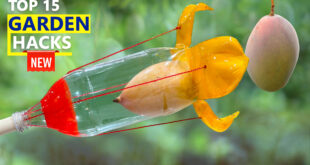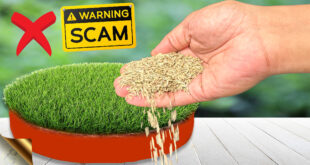In today’s post, let’s look into a very important topic – the 12 golden rules of watering your house plants, the right way. How much? and how often? to keep them healthy!
Water is really amazing – H2O, made up of hydrogen and oxygen, it’s literally responsible for all life on Earth. Watering your plant is a no brainer, but how much and how often can be more tricky to tell. Luckily, we have a few gardening tips and tricks in this episode on watering for optimum plant health. Watering your plants is key to keeping them healthy, apart from a rich soil and good amount of sunlight.
Today, Let’s solve this Frequently Asked Question in Gardening: How much to water plants, and how often to water plants – what should be the frequency of watering? – The answer to this question is not really easy and depends on a number of factors like the Type of plant, your location or the local climatic zone, the season of the year, the type and size of the container and so on..
Now let’s list out the 12 golden rules of watering your house plants, especially applicable to container gardening. You must remember this very important line – OVERWATERING IS THE MOST COMMON PLANT KILLER THAN UNDERWATERING.
Rule 1: Avoid Water Logging and Stagnation – To avoid this, firstly, you need to have a well draining potting soil mix. Your potting mix must contain atleast 30 to 50 percent of stuff other than just garden soil, like compost, peat moss or cocopeat, perlite, vermiculite, sand and stuff like that. You can check the best potting mix formula here. Then secondly, you must check whether the drainage holes of your containers are patent. Water should freely flow out of the holes, else can be a disaster to your plants.
Rule 2: Checking Top Soil for Moisture: Before you water your plant, make it a habit to check the top 1 or 2 inches of soil using the finger dip method. If it’s completely dry then you need to water your plants. You can also check this using a soil moisture meter or a simple moisture and PH testing gadget like this. But the best gadget is your finger! This is important because drying out of soil just before watering promotes growth of roots.
Rule 3: Water less often, but thoroughly – This is really an important rule. Generally for most plants, its better to water less often but thoroughly. This is always much better than watering more frequently with little quantity of water. The next rule, that’s rule 4, explains this concept better.
Rule 4: Water Must Reach the Roots – Most roots are located deeper near the bottom of the containers. Hence superficial watering with small amounts and even though more frequently will not give you good results. Hence thorough watering and less frequent watering is recommended so that the water reaches the deeper roots till the bottom of the container.
Rule 5: Water late in the evening or early in the morning – In late evenings and early mornings, the soil is cooled and hence less water evaporates than it would, on hot soil during the day. And the plants can sufficiently stock themselves with water for upcoming photosynthesis and the plants will be able to deal better with the upcoming heat of the sun.
Rule 6: Keep the Leaves dry to avoid fungus – Generally for most plants, especially for succulents and cacti, it’s recommended to pour water on the soil and not drench the plant completely due to the risk of fungal disease, but this depends on your local climate and the type of plants. If it’s scorching hot in summer, you can mist or drench some of the plants. But not those plants which store water in their leaves and stem like the succulents and cacti, due to the risk or rot.
Rule 7: Water Gradually and Allow it to go down into the soil, wait and water again till the water comes out of the drainage hole. This is thorough watering and important for deeper roots to receive water. As I already said in rule #3 – less frequent but thorough watering.
Rule 8: If you are on a vacation or want to reduce watering frequency, you can use clayrich soil but smartly. This holds water well and this is the soil used by most nursery guys to water their plants less frequently. But there s always a risk of root rot from water stagnation if you use clayey soil. You can also use water retaining gel crystals like the SAP gel crystals or the super absorbent polymer which are now available as non-toxic safe granules which significantly reduce watering frequency.
Rule 9: Different Watering For Different Plants- This is really important specially if you are a beginner. You have to know the name of your plant and also its care tips like watering requirement, sunlight requirement and stuff like that. Do not hesitate to ask the plant identity and google about its care tips and watering requirement.
Rule 10: Container Gardening Vs Ground Gardening – Watering Requirement and Frequency is different for these two types of gardening. Remember this line: Container grown plants dry out much faster, and hence require greater watering vigilance.
Rule 11: Always Water Your Plant after Repotting: so the plant can settle in and stay hydrated while it establishes itself in its new home.
Rule 12: Rather These are Small Tips Like:
– Plants in large pots dry out more slowly than plants in smaller pots.
– Plants in bright daylight dry out more quickly than plants in low light or indoor plants.
– Humid air keeps soil moist for longer, than dry air.
 GKVKs – Gardening Tips and Store Gardening Tips and Store
GKVKs – Gardening Tips and Store Gardening Tips and Store



